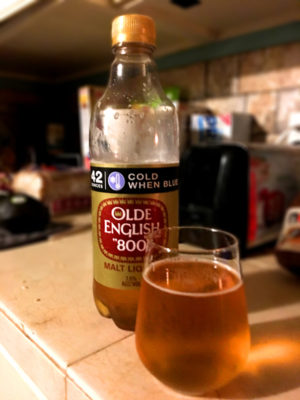
By Aaron Ramson
Olde English 800 may be one of the most popular malt liquors on the market, but what exactly is a malt liquor, and how does it differ from beer? While the craft beer industry is rife with as many niches and sub-genres as indie music does, the malt liquor market seems to exist without the need for evolution. Simply put, smooth drinking and alcoholic is all a malt liquor needs to be.
Although the label originally existed as a general term to describe both beer and ale in the 17th century, the term “malt liquor” wasn’t used as a type of beer until the Grand Valley Brewing Company debuted “Clix Malt Liquor” in 1939. With a label that proudly stated, “Fermented from malted barley and dextrose, with hops,” Clix didn’t hide the fact that sugar was as big an ingredient as barley, while hops was only deserving of a mention. Most beers created post-prohibition were light lagers that averaged around 5% ABV, but this new style was a lager much higher in alcohol than other beers on the market. The drink was light in body, thin and sweetish in taste, and high in alcohol. In the post-prohibition years, a lager that was stronger than your average beer held as much appeal as it does now, and soon enough other breweries began creating similar drinks. When the M.K. Goetz Brewing Company debuted Country Club in the early-1950’s, it surpassed Clix in popularity and quickly became the U. S’s first wildly popular, high alcohol malt liquor.
Colt 45, St. Ides, Schlitz, Mickey’s, Steel Reserve, King Cobra, and Olde English 800 are all brands of malt liquor created by various brewing companies. They all possess similar traits, with a color that ranges from pale straw to amber. While a craft beer is made of malted barley, hops, and water, malt liquors will always have large additions of dextrose (corn sugar or corn syrup) and use an amylase enzyme to break down starches into even more fermentable sugar, resulting in a drink with a much higher ABV than a beer made with just the same amount of barley. Malt liquors are usually lightly hopped with hop extract instead of flowers or pellets, giving mass-market brewers a strong drink that they’re able to sell to consumers cheaply.
While the original denotation between beer and malt liquor was its alcohol percentage, craft beer has muddied those waters greatly through the regular production of high gravity IPAs, strong ales and barley wines. While sugar adjuncts are a staple ingredient in malt liquor production, they’re also occasionally used by craft breweries as well (Dogfish Head Brewing Co has been criticized in the past for their liberal use of corn sugar to boost alcohol in their stronger ales), so even the use of dextrose isn’t what sets malt liquor apart from beer. Although they may look the same, the biggest difference between malt liquor and beer is taste.
 I got my plastic 42 oz. bottle of Old English 800 home and poured it into a glass before taking the first sip. While the appearance and nose may be the same as beer, the flavor of malt liquor is much less bitter and hoppy than even a macro-lager such as a Budweiser or PBR. Sweet with only the slightest hint of grain flavors, malt liquors are best when drank ice cold, where the fusel-alcohol notes from the use of so much sugar are subdued. As it was, the ice-cold bottle of O.E was highly drinkable, and at $2.99, was cheaper and more alcoholic than similar tasting cheap beers.
I got my plastic 42 oz. bottle of Old English 800 home and poured it into a glass before taking the first sip. While the appearance and nose may be the same as beer, the flavor of malt liquor is much less bitter and hoppy than even a macro-lager such as a Budweiser or PBR. Sweet with only the slightest hint of grain flavors, malt liquors are best when drank ice cold, where the fusel-alcohol notes from the use of so much sugar are subdued. As it was, the ice-cold bottle of O.E was highly drinkable, and at $2.99, was cheaper and more alcoholic than similar tasting cheap beers.
Essentially a high-alcohol adjunct lager, malt liquors usually appeal to drinkers who place value and alcohol volume as their biggest motivator when purchasing a beer. Surprisingly smooth and drinkable, the appeal of O.E 800 is its brand recognition through pop culture as much as its pleasant (for malt liquor anyway) flavor. This is a rabbit hole I’m only starting to crawl down, don’t be surprised to see a future installment of Brewtality focus on finding the very best tasting malt liquor on the market.










































